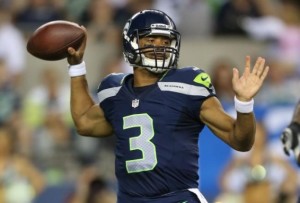Yesterday, I presented the average lead or deficit for each team in the NFL last year, a number I’ve called the “Game Script.” Teams that find themselves with big leads or in deep holes early in games tend to deviate from their game scripts. That’s why it’s important to put metrics like pass/run ratio in context with how the game scripts unfold.
The table below shows the Game Scripts score for each team in all 267 games last year (this includes the post-season). The table is fully searchable and sortable; to shorten the load times, the table by default will display only the top 25 games, but you can change that with the dropdown box on the left (and you can use the previous/next buttons — or the search box — to find other games).
The highest Game Script in a loss was the Peyton Manning-fueled comeback I highlighted yesterday, when Denver was shut out in the first half but blanked San Diego in the third and fourth quarters. The Andrew Luck/Reggie Wayne/#Chuckstrong comeback against the Packers produced the runner up for lowest Game Script in a win (or highest Game Script in a loss, if you prefer). In the playoffs we saw two remarkable comebacks: Wilson’s Seahawks nearly won a game with a -10.8 Game Script against the Falcons, while Colin Kaepernick’s comeback against Atlanta held in a game where the 49ers trailed by 5.6 points, on average, throughout the game.
We can also come up with Pass Identity grades in each individual game, although due to the randomness of any one game, you should be extremely hesitant to draw any conclusions. Still, since it’s easy to calculate each team’s pass/run ratio in each game and to then convert the Game Scripts score and Pass/Run Ratios into Index numbers, I went ahead and ran the numbers. If we add each team’s two Index ratings in each game and subtract 200, we get a measure of the identity of the team as a passing team (positive = passing-oriented game, negative = rushing-oriented).
Take a look at the most pass-happy game from last season, the first row on the table below after the header. Here’s how to read that line: When the Saints played the Bucs in week 15, New Orleans held an average lead of 20.2 points (the Saints won 41-0). In that game, New Orleans called 40 pass plays and just 25 runs, giving the Saints a 61.5 pass/run ratio. By sporting a pass/run ratio that is nearly one standard deviation [1]My definition of standard deviation is based off of the variance among teams over the course of a season; it would be more appropriate to run the standard deviations for teams in each game. Doing … Continue reading above average, the Saints are given a Pass Index score of 112.4 (115 would be one standard deviation above average). With a Game Script nearly six standard deviations above average, they receive a Script Index of 187.5. To pass more frequently in a 41-0 blowout than the average team in all games is quintessential Drew Brees and the Saints, giving them the highest pass identity grade in any game in a season.
I can’t sum up the Romeo Crennel/Matt Cassel/Brian Daboll era any better than this: In week 17 against the Broncos, the Chiefs called 20 pass plays and 28 rushes in a game they lost 38-3 and trailed 21-3 at halftime. If you sort the table by Pass Identity, you can see that Kansas City posted the two run-heaviest games of the year (after adjusting for Game Script). Only twice did a team have a pass/run ratio of 40% or below in a game with a negative Game Script, and Kansas City was the guilty party both times.
References
| ↑1 | My definition of standard deviation is based off of the variance among teams over the course of a season; it would be more appropriate to run the standard deviations for teams in each game. Doing that would significantly increase the standard deviations for both Pass/Run Ratio and Game Scripts. But I’m lazy, and didn’t feel like doing that, especially since this table is really just for rough observations, amusement, and making fun of the Chiefs. |
|---|

